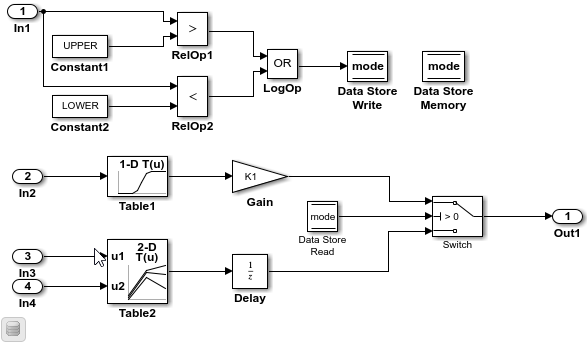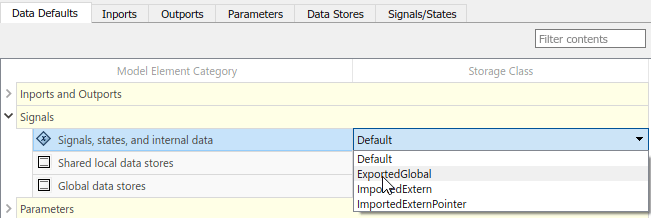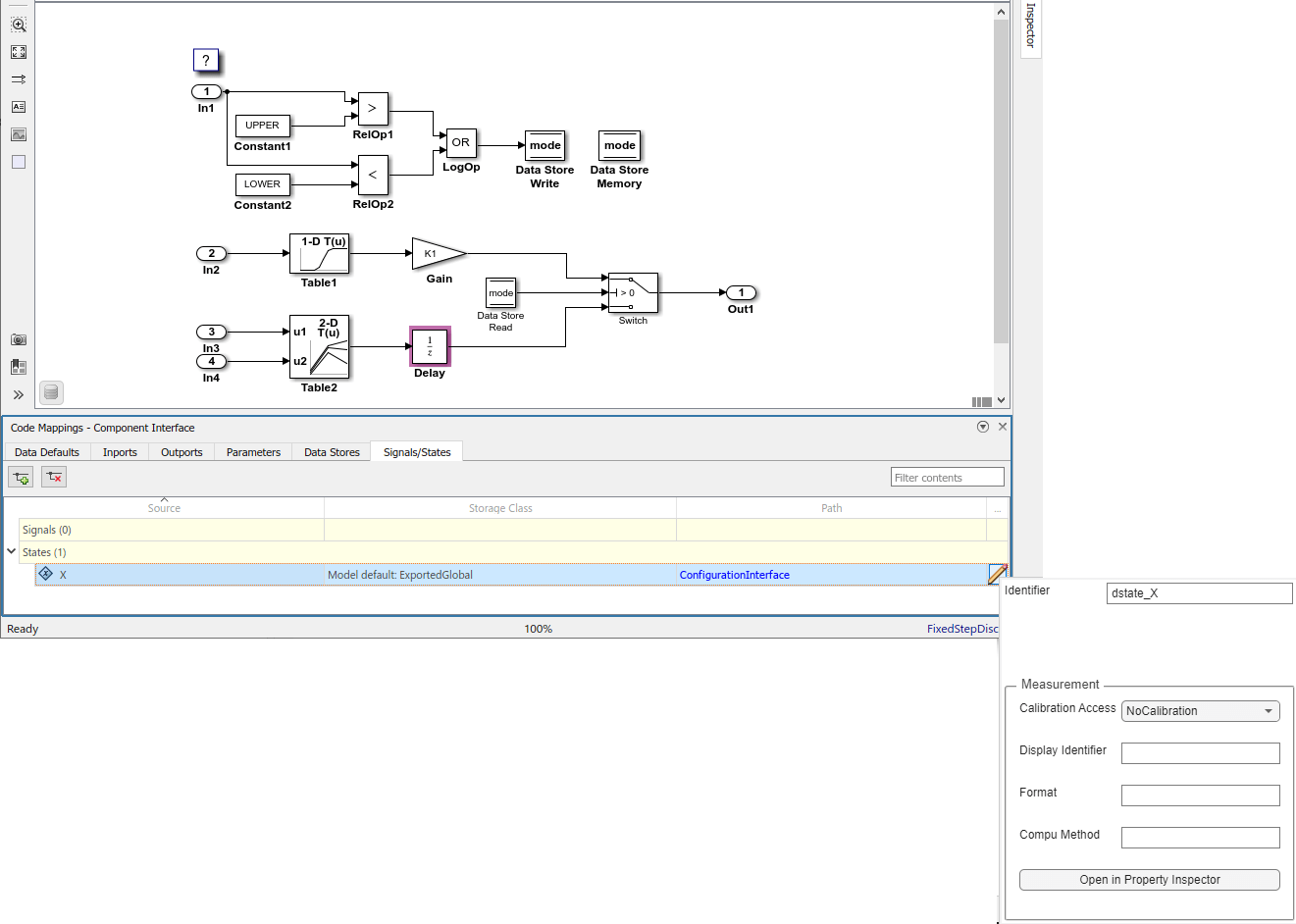Configure Block States for C Code Generation
Block states, such as the state of a Unit Delay block, retain a state value between execution cycles of an algorithm. When configuring a model for code generation, you can configure state data to:
Minimize the amount of data that is stored in memory.
Control where the code generator places state data in memory.
Promote state data to the model interface so that other components and systems can access that data.
Improve readability and traceability of the generated code.
For code generation, examples show how to configure a block state for model ConfigurationRapidPrototypingInterface. You can configure code mappings by
using the Code Mappings
Editor – C or code mappings programming interface (coder.mapping.api.CodeMapping).
Choose Code Configuration Options for States
Based on your code generation requirements, decide how to represent state data. By
default, states in a model appear in generated code as fields of a global data structure named
model_DW
Whether to set up a default configuration
If you need to gain access to a significant number of states (for example, more than 10) , it is more efficient to configure the states with default settings and then override those settings for special cases. If you need to gain access to a few states that have unique source, naming, or placement requirements, consider configuring the states individually.
How to declare and handle state data in the generated code
As separate global variables
To read input data from global variables defined in external code
As calls to access functions. Requires Embedded Coder®
For more information about these options, see Control Data and Function Interface in Generated Code.
Other considerations include whether to:
Name states in the generated code by using state labels that appear in the model or by using unique code identifiers.
Include the
volatiletype qualifier in global variable definitions and declarations. Requires Embedded Coder. See Protect Global Data with const and volatile Type Qualifiers (Embedded Coder).Place state data into a specific area of memory. Requires Embedded Coder. See Control Data and Function Placement in Memory by Inserting Pragmas (Embedded Coder).
For a list of interface requirements that are relevant to states with corresponding storage classes and storage class properties, see Choose Storage Class and Storage Class Properties for Data Stores.
State requirements for example model ConfigurationRapidPrototypingInterface are:
Retain the state data of the Unit Delay block for accessibility while the generated code executes.
Represent the state as a separate global variable.
Apply prefix
dtemp_to the name of the variable that represents the state.
For this example, you set the default representation of the state in the generated code as
a global variable with the static type qualifier. Then, you configure the
state of the Unit Delay block to use the default storage class and a unique code identifier
that includes the required prefix dtemp_. The code identifier capability
enables you to specify code generation identifiers without having to modify the model
design.
Configure Default Code Generation Settings for States
A default code generation setting for states can reduce the effort of preparing a model for code generation, especially if a model has a significant number of states that you want to gain access to while the generated code executes. Choose configuration settings once, and the code generator applies those settings to states across the model. Simulink® stores the default configuration as part of the model.
Consider configuring default code generation settings for model states if your model uses multiple states that do not have unique requirements.
This example shows how to use the Code
Mappings Editor – C to configure default settings for states. Use the Code Mappings
editor to set the default storage class for states in model ConfigurationRapidPrototypingInterface to ExportedGlobal. With that
storage class setting, the code generator represents state data in the generated code as
global variables.
Open model
ConfigurationRapidPrototypingInterface.openExample("ConfigurationRapidPrototypingInterface")
Open the Simulink Coder app.
In the C Code tab, select Code Interface > Default Code Mappings.
In the Code Mappings editor, under Signals, select category Signals, states, and internal data. Set the default storage class to
ExportedGlobal.
Save the model.
Configure Code Generation Settings for Individual States
You can configure individual states for code generation. For example, if a model has two states that have unique code generation requirements, configure the states individually. Or, if you configure default settings for states, you can override those settings for specific states.
If your model meets at least one of these criteria, consider configuring code generation settings for states individually:
Uses multiple states that have unique source, naming, or placement requirements.
Uses a few states.
Has a default configuration for states and you need to override the configuration for some specific states.
This example shows how to use the Code Mappings editor to apply your default storage class
setting to the Unit Delay block state X in model ConfigurationInterface.
The example also shows how to configure a code identifier for that state. You can specify code generation identifiers, for example for integration, without modifying the model design.
If you have not already done so, complete the steps in Configure Default Code Generation Settings for States.
In the Code Mappings editor, click the Signals/States tab. Expand States. The storage class for the state is set to
Auto, which means that the code generator might eliminate or change the representation of relevant code for optimization purposes. If optimizations are not possible, the code generator applies the model default configuration. For this example, the model default configuration specifies storage classExportedGlobal.To avoid optimizations and force the code generator to use the default configuration, set the storage class to
Model default.To override the default configuration, specify the storage class that meets the code generation requirements for that state.
In the Code Mappings editor, select state
X. Set the storage class toModel default: ExportedGlobal.Configure the code identifier for the state with a name that includes the prefix
dstate_. In the Code Mappings editor, select stateX. Click the icon and set the storage class property
Identifier to
icon and set the storage class property
Identifier to dstate_X.
Save the model.
Generate and view the code. For example, in
ConfigurationRapidPrototypingInterface.c, find the data definitions for the state data.real_T dstate_X;
Find where the state data is used in the step entry-point function.
. . . if (mode) { output = (real_T)mp_K1 * dout_Table1; } else { output = dstate_X; } . . . dstate_X = dout_Table2; }
Configure Code Generation Settings for States Programmatically
To automate configuration of states for code generation, use the programming interface for code mappings. For example, when creating custom block libraries or as part of creating an application test environment, use the programming interface to automate data configuration.
This example shows how to use the programming interface to configure states for model
ConfigurationRapidPrototypingInterface. Set the default representation of states in the generated
code as global variables. Then, configure state X of the Unit Delay block
to use the default storage class and unique code identifier that includes the required prefix
dstate_.
Open the example model.
openExample("ConfigurationRapidPrototypingInterface")Create object
cmby calling functioncoder.mapping.api.get. The object stores the code generation configuration for data for modelConfigurationRapidPrototypingInterface.cm = coder.mapping.api.get("ConfigurationRapidPrototypingInterface");Configure default settings for states by calling function
setDataDefault. For the arguments, specify these values:The object returned by
coder.mapping.api.getInternalDatafor the default categoryProperty name
StorageClasswith property valueExportedGlobal
setDataDefault(cm,"InternalData","StorageClass","ExportedGlobal");
Verify your default configuration for states. Issue a call to
getDataDefaultthat specifies the object returned bycoder.mapping.api.getand categoryInternalData. Specify the third argument as propertyStorageClass.getDataDefault(cm,"InternalData","StorageClass")
ans = 'ExportedGlobal'Apply the default configuration for states to state
X.By default, Simulink sets the storage class for individual states to
Auto. The code generator:Determines whether to eliminate the data from the generated code for optimization purposes.
If retaining the data, determines how to efficiently represent the data in the generated code, taking into account default configuration settings.
To control the configuration for a state, call function
setState.Issue a call to
setStatethat specifies:Object returned by
coder.mapping.api.getState name
XDefault storage class previously set for states by using property
StorageClassand property valueModel default.Property
Identifierand property valuedstate_X
setState(cm,"X","StorageClass","Model default","Identifier","dstate_X");
Verify your configuration changes by calling function
getState. Specify the object returned bycoder.mapping.api.get, name of the state, and propertyStorageClassorIdentifier.getState(cm,"X","StorageClass")
ans = 'Model default'getState(cm,"X","Identifier")
ans = 'dstate_X'Save the model.
Generate and view the code. For example, in
ConfigurationRapidPrototypingInterface.c, find the data definitions for state data.real_T dstate_X;
Find where the state data is used in the step entry-point function.
. . . if (mode) { output = (real_T)mp_K1 * dout_Table1; } else { output = dstate_X; } . . . dstate_X = dout_Table2; }
Choose Storage Class and Storage Class Properties for States
Depending on your code generation requirements, choose from these storage classes to configure code generation for block states.
Tip
In the default mappings, states are configured in the section Signals, states, and internal data.
| Requirements | Storage Class for Default Mappings | Storage Class for Individual Mappings |
|---|---|---|
| For data elements that cannot be optimized, represent data as a field of a standard data structure. | Default | |
| Enable optimizations, potentially generating more efficient code. | Auto | |
| Prevent optimizations from eliminating storage for a data element and use the default mapping for the data element category. | Model Default | |
| Generate standalone global variables. Generated code contains the variable declaration and definition. | ExportedGlobal | ExportedGlobal |
| Generate standalone global variables or global variable pointers. Generated code contains the variable or pointer declaration. Your external code provides the definition. | ImportedExtern, ImportedExternPointer | ImportedExtern, ImportedExternPointer |
The list of available storage classes might include other project-specific storage classes defined in an Embedded Coder Dictionary. If you have special requirements that are not met by the listed storage classes and you have Embedded Coder software, you can define a storage class. See Define Service Interfaces, Storage Classes, Memory Sections, and Function Templates for Software Architecture (Embedded Coder).
For an individual state, use the Identifier storage class property to configure a name for the variable representing the state in the generated code. If you leave the Identifier property blank, the code generator uses the State name parameter of the block that has the state. If this parameter is empty, the code generator uses the name of the block.
See Also
Code
Mappings Editor – C | coder.mapping.api.CodeMapping